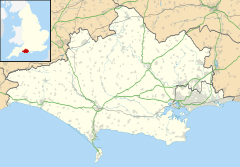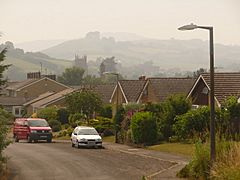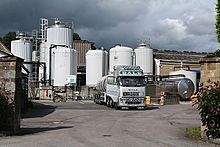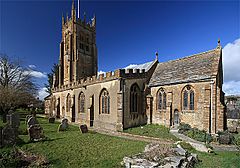Beaminster facts for kids
Quick facts for kids Beaminster |
|
|---|---|
 Beaminster town centre |
|
| Population | 3,100 (2013 estimate) |
| OS grid reference | ST4701 |
| • London | 145 miles (233 km) |
| Civil parish |
|
| Unitary authority |
|
| Shire county | |
| Region | |
| Country | England |
| Sovereign state | United Kingdom |
| Post town | Beaminster |
| Postcode district | DT8 |
| Dialling code | 01308 |
| Police | Dorset |
| Fire | Dorset |
| Ambulance | South Western |
| EU Parliament | South West England |
| UK Parliament |
|
| Website | Beaminster Town Council |
Beaminster ( BEM-in-stər) is a town and civil parish in Dorset, England, situated in the Dorset Council administrative area approximately 15 miles (24 km) northwest of the county town Dorchester. It is sited in a bowl-shaped valley near the source of the small River Brit. The 2013 mid-year estimate of the population of Beaminster parish is 3,100.
Beaminster is the product of the Anglo-Saxon age, dating back to around the 7th century, when it was known as Bebingmynster, meaning the church of Bebbe although the date of origin of the town is unknown. The place name and historic evidence indicates that it was probably the site of a primary Saxon minster church and was at the centre of a large episcopal estate. These are likely to have acted as a focus for a settlement, but evidence of its formation is lacking.
In its history Beaminster has been a centre of manufacture of linen and woollens, the raw materials for which were produced in the surrounding countryside. The town experienced three serious fires in the 17th and 18th centuries; the first of these, during the English Civil War, almost destroyed the fabric of the town.
Beaminster parish church is notable for its architecture, particularly its tower.
Contents
History
In the Domesday Book of 1086 the manor of Beaminster was recorded as being owned by the See of Salisbury. Bishop Osmund gave it as a supplement to two of the Cathedral prebends in 1091.
In the English Civil War the town declared for Parliament and was sacked by Royalist forces in 1644. Prince Maurice stayed in the town on Palm Sunday, though his stay was brief because a fire, caused by a musket being discharged into a thatched roof, almost totally destroyed the town. The town suffered further accidental fires in 1684 and 1781.
Previously Beaminster was a centre for the production of linen and woollens. Flax was grown and sheep kept on the surrounding hills and the town was locally more important than it is today: factories were constructed in the 18th and early 19th centuries, and as many as seventeen inns existed in the town in the early 20th century.
No railway line came through Beaminster and as a result the town declined relative to other local towns such as Bridport and Dorchester.
Horn Park, about 1.5 miles (2.4 km) north-west of Beaminster, is a neo-Georgian country house of five bays and two-storeys designed by architect T. Lawrence Dale and completed in 1911. Inside the house the central corridor is barrel vaulted and leads to a drawing room whose groin vault is reminiscent of the work of Sir John Soane (1753–1837). The drawing room includes Jacobean features re-used from a 16th-century country house at nearby Parnham, which was being altered and restored at about the time that Horn Park was being built. Horn Park is Listed Grade II. Its gardens are occasionally open to the public as part of the National Gardens Scheme.
Geography
Beaminster is sited between 50 to 80 metres (160 to 260 ft) above sea level in a bowl-shaped valley, surrounded by hills which rise to 244 metres (801 ft) at Beaminster Down to the northeast. The River Brit and many small streams emerge from springs on the slopes above the town. The confluences of several of these streams are within the town's boundaries. Beaminster's growth has historically been along the course of these streams, resulting in a settlement pattern that is roughly star-shaped.
Beaminster is situated approximately 45 miles (72 km) south of Bristol, 38 miles (61 km) west of Bournemouth, 35 miles (56 km) east of Exeter and 15 miles (24 km) northwest of the county town Dorchester.
Geology
Beaminster is sited mostly on Middle Jurassic Fuller's earth clay, with some Inferior Oolite in the south of the town and Bridport and Yeovil Sands north of the town centre. The hills north and east of the town are Cretaceous chalk with a scarp face of Upper Greensand, while those to the south and west are of Bridport and Yeovil Sands. There are several faults running westnorthwest to eastsoutheast through the town and its southern environs. Horn Park Quarry SSSI produced building stone from the Inferior Oolite and some quality fossil specimens before becoming a light industrial estate on the road to Broadwindsor. Apart from the ammonites, the site displays a remarkable flat erosion surface and the most complete succession in the Upper Aalenian ironshot oolite limestone of the area.
Demography
Beaminster parish
Dorset County Council's 2013 mid-year estimate of the population of Beaminster parish is 3,100.
The historic population of Beaminster parish from the censuses between 1921 and 2001 is shown in the table below.
-
Census population of Beaminster Parish 1921-2001 Census 1921 1931 1951 1961 1971 1981 1991 2001 Population 1,651 1,612 1,785 2,000 2,350 2,370 2,770 2,920
Source: Dorset County Council
2011 census
Published results from the 2011 national census combine information on Beaminster parish with the small neighbouring parish of Mapperton to the southeast. Within this area there were 1,680 dwellings, 1,529 households and a population of 3,136.
Economy and society
DuPont produce Nisaplin (E234), a commercial formulation of the natural bacteriocin nisin, at a factory in the town. It was first isolated by Aplin and Barret and produced in the 1950s in the factory laboratory then at 11–15 North Street. The Clipper tea company is based in Beaminster. It is currently owned by the Dutch company Royal Wessanen.
Beaminster hosts the Beaminster Festival, an annual music and art festival. Whitcombe Disc golf course at Beaminster has hosted the British Open Disc Golf Championship several times and the European Disc Golf Championship in 2003. The town is twinned with the town of Saint-James on the Brittany/Normandy border in France.
Buckham Fair, a fundraising vintage fair held annually on land near the town, took place for ten years until the last event in 2018. As of 2020, the fair has been indefinitely postponed.
Transport
The nearest railway station is 5 miles (8 km) north of the town at Crewkerne. Exeter International Airport is 30 miles (48 km) to the west. The main road through the town is the A3066, which leads to Bridport to the south and Mosterton and Crewkerne to the north. The road north passes through Horn Hill tunnel, which opened in June 1832 and is the sole pre-railway age road tunnel that is still in daily public use.
Religion
Beaminster has an Anglican church, St Mary's, and a Catholic church, St John's. St Mary's is notable for its architecture, which is considered among the best in the county. The tower in particular has been described as "a handsome example of its period" and "the glory of Beaminster". St Mary's construction mostly dates from the 15th and 16th centuries, but was restored twice in the 19th. The eastern part of the north aisle incorporates part of an earlier 13th-century building, and the font bowl is late 12th-century. The pulpit is Jacobean.
In literature
Beaminster is described as "Emminster" in the fictional Wessex of Thomas Hardy's Tess of the d'Urbervilles.
Dorset's 19th-century dialect poet William Barnes wrote of Beaminster:
Sweet Be'mi'ster, that bist a-bound
By green and woody hills all round,
Wi' hedges, reachen up between
A thousand vields o' zummer green.
Twin towns
Beaminster is twinned with:
Education
Primary schools in the town include St Mary's Church of England Primary School.
Beaminster School is the town's secondary school. It has a combined sixth form with The Sir John Colfox Academy, in the nearby town of Bridport.
Beaminster is also home to Mountjoy School co-sharing the site of Beaminster School.
Hooke Park is the woodland campus of the Architectural Association School of Architecture.
Notable people
- Beaminster was the boyhood home of the Arctic explorer, naturalist and author Samuel Hearne. Hearne is considered by some to have been the inspiration for the tragic figure in Samuel Taylor Coleridge's The Rime of the Ancient Mariner.
- Beaminster is the adopted home town of actor Martin Clunes.
- Mat Follas had his first restaurant The Wild Garlic in the town square, though in 2013 it was moved to larger premises elsewhere.
- Beaminster is also home of Lynne Reid Banks, author of The L-Shaped Room and The Indian in the Cupboard; both books were filmed.
- The furniture maker John Makepeace lives in the town after selling nearby Parnham House, where his school for craftsmen in wood was originally based. Alumni of Parnham House include David Armstrong-Jones, 2nd Earl of Snowdon. Parnham was also the home of William Barnard Rhodes-Moorhouse, the first airman ever to receive the Victoria Cross, following a daring, though ultimately fatal, bombing mission over Courtrai in 1915.
See also
 In Spanish: Beaminster para niños
In Spanish: Beaminster para niños





